State of Design 2014
For those who might be new to my column, today is an article I do every year called "State of Design." It is modeled after a speech the president of the United States gives each year, where he talks about how he feels the country is doing. My equivalent is to write an annual article where I look over the previous year of design, talk about what I felt went right and what went wrong, and then discuss how I feel Magic design is doing. Each year, I create three goals for the upcoming year and look back at the three goals from the previous year to see how we did. This is my tenth State of Design column (yeah, saying that makes me feel old).
Here are my previous nine articles:
I always start by asking the same question: How was the last year for Magic design? My answer for the last year is good but not great. Theros is currently the best-selling Magic set of all time. I've received a lot of positive comments about the Theros block. In addition, players are very upbeat about the other Magic products we've created during the last twelve months. But none of that means this last year was perfect. We did a lot of things right but we also made a few mistakes. My goal with Magic design is to constantly improve, making each year better than the year before it. In some ways, I feel we did this; but, in some others, we didn't. I'm going to talk about all that today.
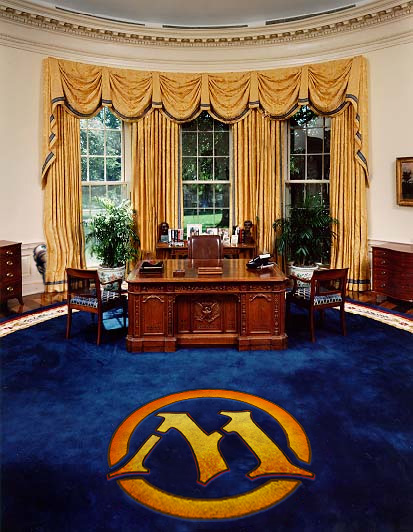
Traditionally in this article I begin by discussing what we got right:
Highlights of 2013/2014
We Nailed the Top-Down Design
When we started designing Theros, I felt as if I had Innistrad on my shoulder. I was so happy with how the top-down design went with that set that I was a little dubious I would be able to do another top-down design that resonated as well. Greek mythology was also a lot trickier than Gothic horror. People's experience with the horror genre comes from movies and television—things that allowed players a shared world. Greek mythology is something most people have experienced through books, a medium where readers get to create their own takes on the world they are reading. This meant that different people would have different expectations.
Also, watching zombies or vampires through mass media meant you had a sense of how they function and what they do. We didn't have that with Greek mythology. How do a group of zombies act? Everyone knows that. How do centaurs behave? Nowhere near as clear.
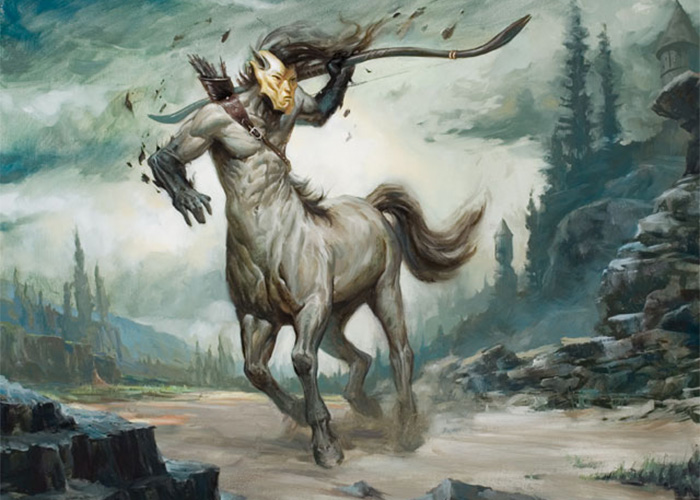
Returned Centaur | Art by Lucas Graciano
What this meant was that we had to approach this top-down design differently. I am quite happy to say, I believe we succeeded. The Gods were a huge success. The flavored mechanics were mostly successful. The individual cards that hit upon all the myths were super popular. I feel like there were a lot of expectations and that we managed to hit most of them all while creating a set where the very play reinforced these themes.
We Rehabilitated a Mechanic
One of the most important things we did this year was to try an experiment where we took a mechanic that failed the first time through and brought it back with a new makeover. Obviously, that mechanic was devotion (formerly chroma from Eventide), and it was a huge success. One of the ways you could tell I considered this task important was that I made it one of our goals for this year. Magic design is a finite resource and if we're planning to make a game that outlasts us all, we have to be careful about how fast we eat up design space.
There are many solutions to this problem, but an important one is having the ability to reexamine mechanics we've already done. If good ideas were executed poorly, we have to be able to find them and try to give them new life. I started with a mechanic I had a lot of faith in, one that I knew had more potential than its initial reaction. Nonetheless, failure in this experiment would have set back plans to try to do this more often, so I'm very happy it was a success.
We Found a Whole New Format
It's important for us to keep trying new things, but not every product we make is going to be a runaway success. So when we make one, it's a cause for celebration. Shawn Main had an idea for a very quirky product, a Limited product where you had to draft it and then play multiplayer and there were things that affected the draft. When Shawn first pitched the idea, it sounded offbeat, and while R&D had a lot of faith, there were many in the company who were skeptical.
Well, Conspiracy is now kicking major butt. I've had so many positive responses to it, even from players who never thought they would play a product like it in a million years. I love how Magic is constantly reinventing itself and Conspiracy is a perfect example of how there are many untapped great ideas still waiting to be found.
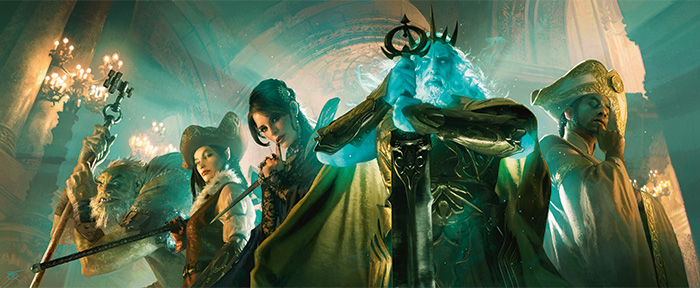
Art by Michael Komarck
So congrats, Shawn (and his design team, and Dave Humpherys and his development team), you guys did a great job.
While many things went well this last year, there were a few things that didn't go quite as smoothly:
Lessons of 2013/2014
We Messed Up on Born of the Gods
One of the banes of Magicdesign is third sets. They're just tricky to do. We have to innovate enough to make them fresh after eight months of players being exposed to the block, but we can't deviate too much or else it doesn't feel connected. Obviously, one only needs to look at sets like Rise of the Eldrazi and Avacyn Restored to see that we've gone to great lengths to try and make third sets work.
But wait, wasn't Born of the Gods the second set? Yes, it was. See, I was so concerned with making sure the third set worked that I made the second set give up too much. We finally made a worthy third set only to realize it came at the cost of the second one.
Let me quickly jump in and say that this problem was not because of Ken Nagle, the lead designer of Born of the Gods, but because of me as the head designer. I'm the one who called the shots and decided what went where and, if the second set was lacking, it's because I was saving stuff for the third set. Which leads us to the next lesson:
We Mishandled Enchantment Matters
Players have been wanting an enchantment block for a long time. We finally gave them one, but in doing so I took away something they were expecting. You see, I knew the expectation of an enchantment block would be things that would allow players to craft enchantment-heavy decks. It's what we did with artifacts, it's what we did with the graveyard, it's what we did with tribal. We finally focused a block on enchantments and then didn't let players build the decks they had been dreaming to build when we finally did an enchantment block.
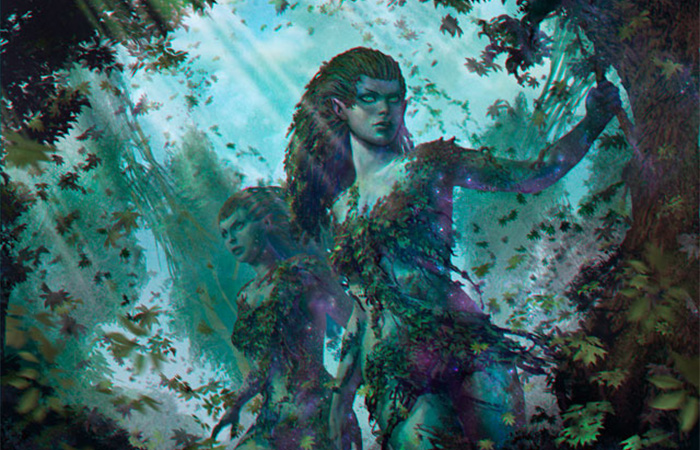
Oakheart Dryads | Art by Johann Bodin
It's not that the block didn't deliver this, because it did. It just delivered it too late. I knew the third set needed us to withhold something, and "enchantment matters" seemed like the perfect fit. It was a mechanical area we didn't have to use early on but something that, when we did, would tie everything together. It sounded so good on paper. Here's the problem: Design isn't just about execution of your vision, it's about matching expectations.
I feel we succeeded in meeting the player expectations of a block inspired by Greek mythology but we failed, at least for two-thirds of the block, to deliver what players had expected of an enchantment block. I had tried early on with messaging to keep players from this expectation, but I was fighting human nature and, as I always say, that's a losing battle. When you revisit a theme you can do something different, but the first time you do it, you have to meet some basic expectations.
Looking back, I needed to find a different hook for Journey into Nyx and I needed to spread the "enchantment matters" throughout the block. Maybe I could have just withheld it from Theros and started handing out the goodies in Born of the Gods. What I do know is making players wait eight months (during which they didn't know it was coming) for something they expected to see Day One.
We Should Have Kept Monstrosity for the Whole Block
One of the problems with a block is the pressure to both keep everything you've introduced while also doing new things each set. I worked very hard in Theros block to find reasons not just to add things but also to take things away. Looking back, choosing to do that with monstrosity was a mistake. The original plan was to have monstrosity in the first set, tribute in the second set, and then a "+1/+1 matters" mechanic in the third set. This obviously didn't work out and we ended up bringing back monstrosity.
With 20/20 hindsight, it's clear that we shouldn't have done tribute. We could have saved it for another day and monstrous could have stayed. It would have meant that Born of the Gods only had one new mechanic, inspired, but I think that would have been okay (especially if we had designed it to be easier to build around). Monstrosity had plenty of design space left and it was very flavorful.
Third and Goal
Now that I've talked about the highs and low of the year, it's time to look back at the goals I set for this year and see how we did. Remember that success of the goals is not based on the attempt, because I always choose things I know we're going to try, but on the reception of the playerbase. Did all of you like the thing in question? Let's see how we did. As you will see, the goals were tied into the year's highs and lows.
2014 Goal #1: Show That We Understand How to do Top-Down Design
One of the popular topics on my blog has been what other real-world influences would make for good top-down designs. I feel like this topic is kind of symbolic of how players have responded to top-down design. It isn't "Should we do more?" it's "What should we do?" which makes me feel that Innistrad and Theros blocks have connected well with the players.
But let's try a different criteria. What does all our player feedback tell us? The Gods, especially the monocolor ones, scored very well. The individual cards that strongly conveyed a Greek trope (Chained to the Rocks, Rescue from the Underworld, etc.) scored well. The mechanics, in Theros especially, which were closely tied to the flavor, also scored well.
The biggest complaints were about areas that we didn't manage to make cards. Where was Hercules? The Golden Fleece? The minotaur in the maze? But mostly, people seemed pretty happy that we hit most of the expected Greek-mythological tropes. I'm going to chalk this goal as a success. A full thumbs up.
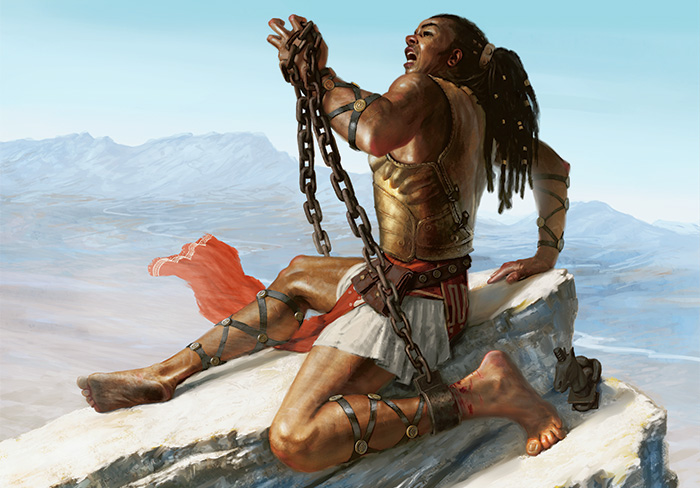
Chained to the Rocks | Art by Aaron Miller
2014 Goal #2: Show That We Can Execute an Enchantment Block
This goal's success is a little fuzzier. I feel we did a good job with the enchantment creatures. We introduced them in a way that made them organic and they helped create a unique play environment. Bestow proved to be a little more complex than we had thought, but players embraced the mechanic.
Players seemed less happy about the absence in the first two sets of the global enchantments and, as I talked about above, they really missed having no "enchantment matters" cards in either Theros or Born of the Gods.
My takeaway is that, had this been the second enchantment block we had done, where we had done all the low-hanging fruit the previous time, we would have been good. The fact that this was the first real enchantment block (I'm told Urza's Saga block doesn't count) and we withheld a lot of low-hanging fruit until the third set meant we didn't execute to meet player expectations as well as we could have, at least early on. I give this half a thumbs up.
2014 Goal #3: Show That We Can Reinvigorate a Mechanic
If anything, we succeeded with devotion a little too well. Development really thought it was fun, so the team pushed it, and the mechanic turned out to be the most influential Theros mechanic in Standard. The feedback on devotion was very positive (until it started warping Standard), but this is a design review and not a development one, so I'm looking more at the initial response.
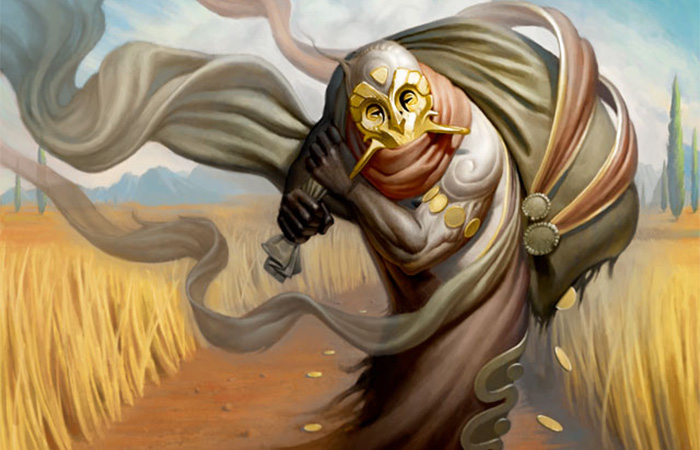
Gray Merchant of Asphodel | Art by Robbie Trevino
Here, by the way, are the lessons I learned from the experience:
- Flavor is key—Chroma is a flavorless word. Devotion is not. Having devotion means something helped give the mechanic an emotional weight that chroma never had.
- Focus is important—Chroma worked anywhere. Devotion just cared about the permanents on the battlefield. That focus made it easier to know what you were supposed to care about and made deck building pretty straightforward—put permanents with a lot of mana symbols in your deck, probably stay in monocolored.
- Execution is crucial—Erik Lauer hit in on the head about one of the biggest reasons for chroma's failure: "None of the cards were any good." We worked hard with development to make sure we made cards the team would be able to push.
It's pretty clear that this goal was a huge success. Another thumbs up.
That means we went two-and-a-half for three. Pretty good. Let's take a look at next year's goals:
2015 Goal #1: Prove We Can Handle the Volume Without Excess Complexity
Khans of Tarkir block has a lot going on. A lot going on. The block structure is one of the hardest ones we've ever attempted. The set is bringing back morph, one of the most complex mechanics we've ever done. It has five distinct, different, three-colored wedge groupings, each with its own mechanic. We're doing all that while trying to make the mechanics tie into a very involved story while still keeping New World Order. And that's just the first set in the block.
This goal is to accomplish everything we're trying without confusing the players. Will the themes come through? Will the mechanics interact like we want? Will all of it resonate?
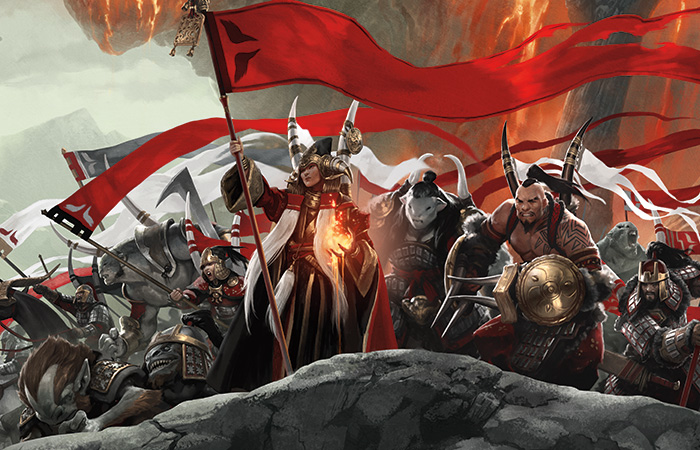
Art by Jason Chan
I believe it will, so I'm optimistic about this goal, but it's definitely the most moving parts I've had in a post–New World Order block. This goal is basically: Can we pull it all off without overly confusing the players?
2015 Goal #2: Demonstrate That the Block Model Works
The three sets in this block are connected through a complex web of mechanics. It's early, so I can't explain exactly what I mean, but as the block evolves you all will get a chance to see for yourselves. Never before have all the mechanical pieces been so interconnected. This goal looks at the relationship between all the mechanics and asks, "Did the execution live up to the ideal?" We have a cool block structure. Did it work?
2015 Goal #3: Execute Properly on "Dewey"
Two years ago, I talked about how the trouble set of the Return to Ravnica block was going to be the execution of Dragon's Maze. One of my goals was about that execution. I feel "Dewey" is the same thing, but for Khans of Tarkir block. It is quite literally the set the entire block hinges on. Can we make a small set that is different things to different large sets? Can it draft well with Khans of Tarkir and then draft well, but differently, with "Louie?"
Dragon's Maze failed in its execution goal. Can Dewey fare better? Can we create a set with its own identity that compliments two different large sets—sets that are very different from one another? That's what this goal is testing.
And That's the Year That Was
My "State of Design" articles are meant to be introspective, which means I'm very eager to find out how you all think the last year's worth of design went. Write me an email or connect to me through any of my social media (Twitter, Tumblr, Google+, and Instagram) to tell me your take on the current state of design.
Join me next week for an article I guarantee you everyone is going to be talking about.
"Drive to Work #148 & 149—Unhinged, Parts 2 & 3"
My two podcasts today are Parts 2 and 3 of my five-part series on the design of the silver-bordered set Unhinged.
- Episode 149 : Unhinged, Part 3 (16.1 MB)
- Episode 148 : Unhinged, Part 2 (15.0 MB)
- Episode 147 : Unhinged, Part 1 (17.0 MB)
- Episode 146 : Restraint (14.3 MB)
- Episode 145 : Getting a Job in R&D (15.7 MB)
- Complete Drive To Work Podcast Archive

